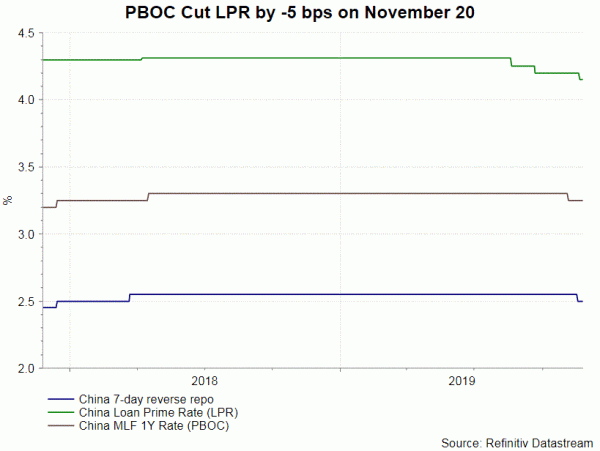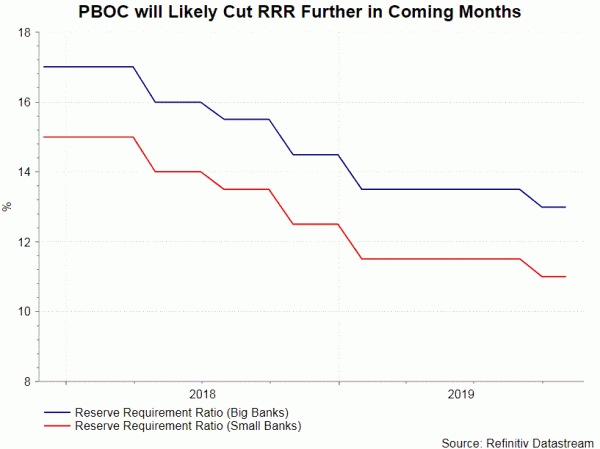We expect China’s monetary policy will be more expansionary in coming months as the economy slows further. Struggling between boosting growth and curbing CPI acceleration, the authority has probably chosen the former. Meanwhile, PBOC is obliged to do more as fiscal stimulus remains modest.
PBOC has lowered interest rates three times this month. Last week (Nov 20), it cut the 1-year and 5-year Loan Prime Rate (LPR), each by 5 bps, to 4.15% and 4.80%, respectively. Preceded by the -5 bps cut of MLF rate on November 5, reduction in the 1-year rate was widely anticipated. However, the 5-year rate was lowered for the first time since the LPR was introduced. Meanwhile, the central bank also lowered the 7-day reverse repo rate, by 5 bps, to 2.5% on November 18.
 There are several reasons for a more easing policy stance. October data revealed weakness in domestic growth. All key indicators missed expectations. Credit growth also missed expectations last month. PBOC Governor Yi Gang last week noted that the central bank would step up credit support to the real economy and lower loan costs. Meanwhile, despite optimism over US-China trade negotiations, uncertainty remains with regard to when a phase I agreement will be finalized. It is likely that a final version will be delayed to early 2020.
There are several reasons for a more easing policy stance. October data revealed weakness in domestic growth. All key indicators missed expectations. Credit growth also missed expectations last month. PBOC Governor Yi Gang last week noted that the central bank would step up credit support to the real economy and lower loan costs. Meanwhile, despite optimism over US-China trade negotiations, uncertainty remains with regard to when a phase I agreement will be finalized. It is likely that a final version will be delayed to early 2020.
Strong inflation is handcuffing the central bank’s monetary policy. Headline CPI accelerated further to +3.8% y/y in October, beating consensus of +3.4%. This also marked the first time since 2013 that headline CPI has breached the +3% target. Food price, in particular pork price, was again the key driver for the strong inflation. However, non-food price only climbed +0.9% and core inflation remained mild a +1.5%. A stimulus monetary measure would inevitably send inflation higher. Yet, it appears that the authority would look through the headline reading and focus on softness in macroeconomic data, loan growth and underlying inflation.
On the monetary policy outlook, we expect PBOC will lower the policy rates further. However, the move would be mild each time. We expect it will cut the MLF rate by another -5 bps in December, leading to a -5 bps reduction in the 1-year LPR. We also expect PBOC to reduce the reserve requirement ratio (RRR) by 50 bps. This could come in as soon as Lunar New Year (January 2020).















